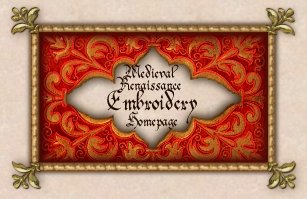
(Timothy J. Mitchell CompuServe: 71461,303)
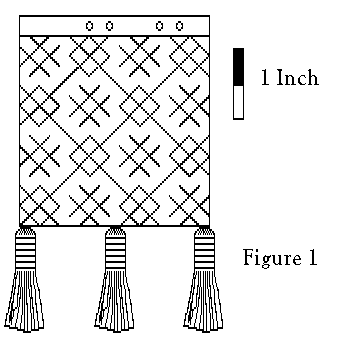
|
The bag dates from late 14th or early 15th century Germany and is an excellent example of a type of counted thread embroidery popular at the time. The embroidered bag is worked on 28 count linen fabric and measures approximately 3 inches square, excluding the tassels.
|
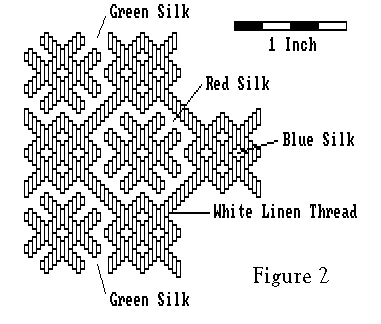
|
The geometric design is stitched in multiple ply linen thread (see Figure 2) and the background filled in with green, red, and blue silk floss. Three silk tassels bound in gold or gilt thread hang from the bottom of the bag, they are colored gold, green, and red respectively. The original is on display in the Victoria and Albert Museum Textile Room, European embroidery, frame I-9, Item no. 8699-1863. A grey-scale scanned photo of this piece is available in the Living History Forum (GO LIVING), Library 12, Garb and Costuming: Gerbag.gif.
|
Materials:
|
The first step in construction is to embroider the material. Lay out
the evenweave and mark out a rectangle the height of your bag and twice
as wide: in the case of the original, this would be 3 inches by 6. Mounting the fabric firmly in a hoop is recommended as this type of needlework tends to pull and twist the fabric a bit. The embroidery is worked using all six strands of the floss and I have found that it is easiest to do the white geometric design first, filling in the colored areas as sections are completed. The floss is stitched over two, four, or six of the evenweave threads (see Figure 3) depending on what part of the pattern is being worked.
As is shown in Figure 3, the path of the stitch through the fabric is
parallel to the weave as in Florentine and Bargello work instead of crossing it as cross-stitch does.
|
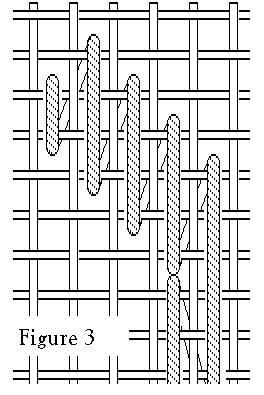
|
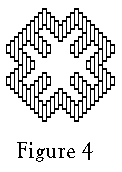
|
The design in Figure 2 is worked in White (DMC 746) out to the edge
of the marked rectangle; then in turn, each background space is filled in with either Green (DMC 368) or Red (DMC 347) using the stitching pattern in Figure 4. The small squares are filled using Blue (DMC 312).
|
The tassels that decorate the bottom of the bag can be made as follows: Place two finishing nails in a small piece of wood so that they are firmly attached but most of their length is exposed. The nails should be one and one-half inches apart. The three tassels are colored gold (DMC 729), green (DMC 368), and red (DMC 347). Take a skein of the color you wish the tassel to be and wrap the floss around the nails 24 times. Then use some of the remaining floss to wind tightly around a quarter-inch length of one end of the resulting hank, forming the top of the tassel. After tying this off securely, you can then cover the tie with gold thread if you wish. To finish the tassel, cut through the threads at the untied end and remove the tassel from the nails; finally, comb out the end of the tassel gently, and trim it neatly. The finished tassels are sewn to the bottom seam of the bag. Those who wish can line the bag with a lightweight material such as silk.
Although the drawstring is missing from the original pouch, the paired holes in the top of the original piece suggest how it may have at one time been attached (see Figure 1). Another bag of the same period, this time from France, sheds more light (see Staniland, pg 43 for a good color photo). The French purse is of a totally different needlework style, but the basic design of the pouch is the same as the one in the V+A. This purse is closed with two drawstrings, each ending in a tassel. Two more tassels are attached directly to the purse for use in pulling it open (see Figure 5). On the French purse these tassels are colored in pairs, one color for opening, one for closing.
The finished bag has a heavy, rich, brocaded feel to it, and is fine addition to the rich costume of its time.
Staniland, Kay, Medieval Craftsmen : Embroiderers. London: British Museum Press, 1991. ISBN 0-7141-2051-0, œ6.95.

This article and its illustrations may be copied for personal use only. Permission to reprint this article may be obtained from the author:
Timothy J. Mitchell
CompuServe: 71461,303
Internet: 71461.303@compuserve.com

Later published in the Summer 1993 issue of TOURNAMENTS ILLUMINATED, the Official publication of the Society for Creative Anachronism Inc.


